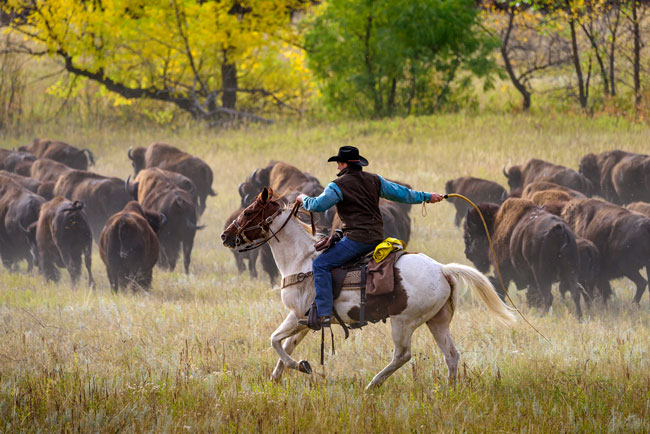

Like a scene from Dances with Wolves, hundreds of North American Bison thunder across the prairie flanked by teams of riders on horseback.
Crack! Bullwhips bite the air, keeping the mighty beasts moving over rolling hills in Custer State Park in southwest South Dakota. They run toward two openings in a fence where eventually they are pigeonholed into a corral. After the buffalo roundup, the animals are branded, vaccinated, tested for pregnancy and sorted for auction as part of the park’s resource management program of 53 years.
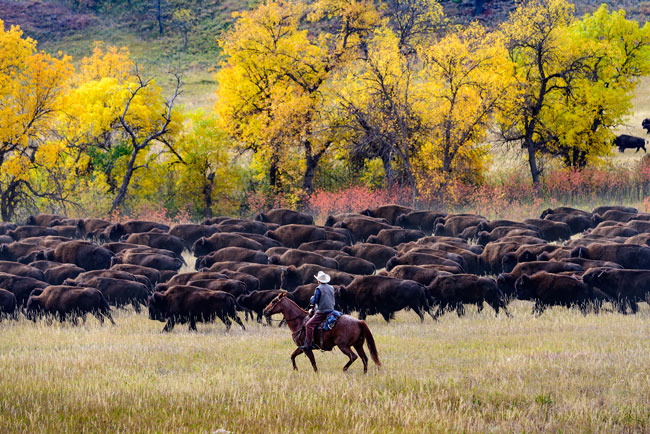
Custer State Park Buffalo Roundup
The annual Buffalo Roundup, as it’s called, is held the last weekend in September. It’s a cowboy-movie spectacle for thousands of visitors who get up at the crack of dawn to drive for miles to the staging area for a good viewing spot. But this western experience is not just city-slicker fun for park staff and volunteer wranglers.
Two weeks earlier, they began flushing out the herd of 1300 — one of the largest publicly owned bison herds in the country — that roams freely throughout the 71,000-acre park in the Black Hills.
“They look docile and tame, but they’re not,” said the assistant herd manager. He told me bulls that can weigh as much as 2000 pounds have been known to gore the horses, though that’s rare. “They [both males and females] have horns, and they know how to use ’em,” he said.

That’s why they use pickup trucks driving alongside the stampeding herds, spoiling the Old West atmosphere a bit with a touch of 21st century reality. The chase vehicles are there for riders’ safety and carry VIPs and journalists who brave the dusty, bumpy ride to get up close and personal with the animals.
I chose, instead, to view the scene safely from afar atop a bluff called Governor’s Hill with then-Governor Mike Rounds and his family.
Buffalo Roundup & Arts Festival Weekend
In recent years, the Governor’s office has used the Buffalo Roundup as an economic development opportunity for the state. People who might want to start and grow businesses in South Dakota are invited to schmooze with the governor and other business leaders at the Roundup weekend that includes activities showcasing the state, such as fly fishing, horseback riding, canoeing, a buffalo safari, a winery tour, and a visit to Crazy Horse Memorial and the night lighting ceremony of Mount Rushmore.
For the general public, the weekend includes an art show, entertainment, a pancake breakfast and a buffalo-meat chili cook-off as well as watching branding and vaccinating of the animals following the signature event.
“The roundup never gets old for us. It’s part of our identity,” says Jamie Rounds, brother of the governor
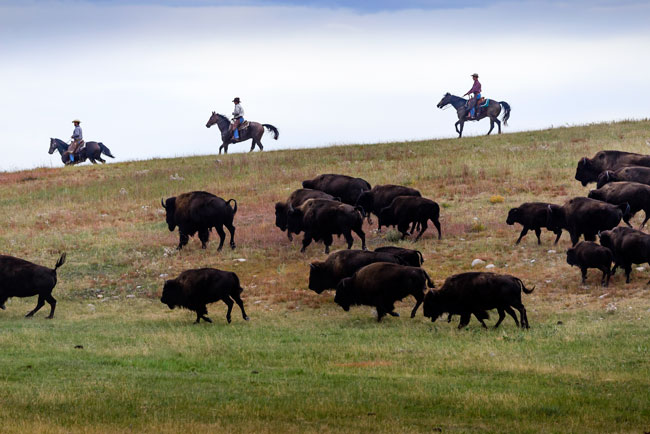
History of the Bison
Indeed, the North American bison has been identified with the Great Plains for centuries. More than 60 million once roamed the area, hunted by the Native Americans who utilized the entire animal for food, clothing, shelter, tools, weapons, ornamentals, medicine, and a myriad of other uses for their nomadic lifestyle. But with the westward expansion in the 1860s, the bison were nearly exterminated.
The white man slaughtered them to feed railroad workers, to supply a burgeoning leather industry, and, most importantly, as a means to get rid of the natives by eliminating their food supply. A chilling photograph of an American soldier standing in triumph on top of a pile of thousands of bison skulls says it all (at the Oglala Lakota College Historical Center on the Pine Ridge Reservation.) By the end of the 19th century, less than 1,000 bison remained.
In 1905, conservationists Theodore Roosevelt and William Hornaday founded the American Bison Society to help save the bison from extinction. Currently, the bison population is about 500,000. But 90 percent live in commercial herds, with wild bison roaming on only about one percent of their former range.
And to clear up a misnomer, even though they are commonly referred to as buffalo, American Bison are not buffalo. Buffalo are distant cousins that live in Africa and Asia, as a visit to any zoo will tell you.
Tatanka, Story of the Bison
Filmmaker Kevin Costner, who directed, produced and starred in the 1990 award-winning Dances with Wolves, built an education center just outside of Deadwood, SD in 2003 named Tatanka, Story of the Bison.
Inside, the center is filled with one of the best exhibits interpreting the Native American culture and its relationship with the bison. Outside, stands an extraordinary larger-than-life 17-piece bronze sculpture of natives on a bison hunt created by Peggy Detmers and commissioned by Costner.
Crazy Horse Memorial
A man’s dream and lifetime’s work are wrapped up in the Crazy Horse Memorial in the Black Hills. Since 1948, sculptor Korczak Ziolkowski and workers have been creating what will be the world’s largest mountain sculpture.
At the request of Lakota Chief Henry Standing Bear, Ziolkowski started the project at age 40, dedicating the rest of his life to carving the likeness of the Lakota leader Crazy Horse to honor North American Indians. With Ziolkowski and his wife Ruth deceased, four of their 10 children and some of their 23 grandchildren continue to work on the 563-foot-high carving-in-the-round through the Crazy Horse Memorial Foundation funded entirely by private donations.
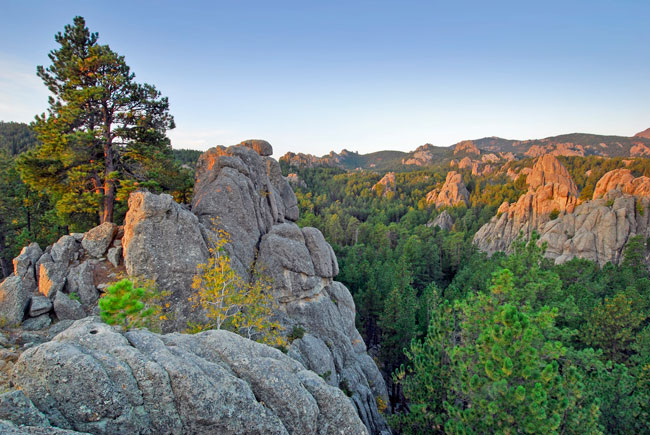
The Black Hills of South Dakota
“In this country, there exists a national amnesia about what happened to our ancestors,” said Lakota native Sanka Manitu Oh Canku, also known as Billy, a guide at Tatanka.
Some 62,000 Native Americans live in South Dakota. They believe their very creation began in the Black Hills — 6,000 square miles of pine-covered mountains, rocky spires, streams, lakes, and wildlife. It is hallowed ground to them.
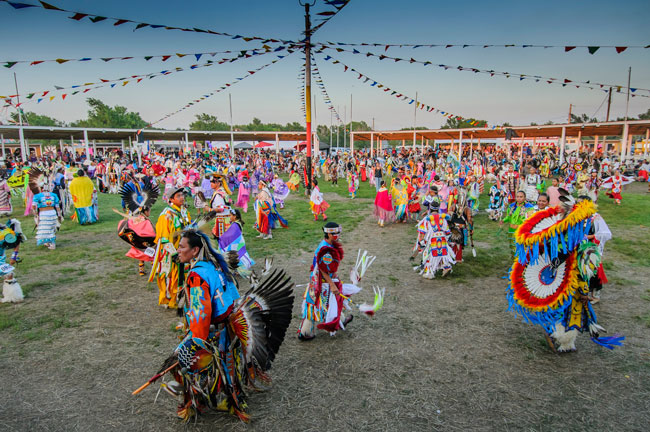
In the 1868 Treaty of Fort Laramie, the U.S. promised the Sioux “undisturbed use” of the Black Hills in exchange for safe passage for the white man. When miners found gold in French Creek, that changed everything, and by 1877 congress officially “took back” the Black Hills.
Much later, it added salt to the wound by carving the faces of four U.S. presidents into the sacred stone. The U.S. has offered more than $100 million reimbursement to the natives. The Sioux refused it — they just want their land back.
If You Travel to South Dakota
Lodging: State Game Lodge, custerresorts.com
Custer State Park is about an hour from Rapid City
visitcuster.com
South Dakota Tourism
travelsouthdakota.com
Author Bio: Claudia Carbone is an award-winning journalist based in Denver. She contributes regularly to GoWorldTravel and writes Sleepin’ Around – A Hotel and Travel Blog on this site.
- How to Renew a US Passport Quickly and Affordably - April 19, 2024
- 6 Reasons to Visit Portland, Maine (+ Travel Tips) - April 18, 2024
- Cruising with Discovery Princess on the Mexican Riviera - March 30, 2024
